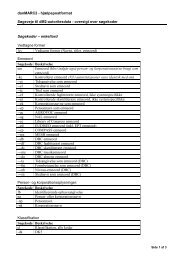RFID Data Model for Libraries - biblstandard
RFID Data Model for Libraries - biblstandard
RFID Data Model for Libraries - biblstandard
Create successful ePaper yourself
Turn your PDF publications into a flip-book with our unique Google optimized e-Paper software.
<strong>RFID</strong> <strong>Data</strong> model <strong>for</strong> libraries Doc 067<br />
Part 3 - The <strong>Data</strong> <strong>Model</strong> proposal<br />
This data model is the proposed normative content of this proposal and covers the user data<br />
area of the <strong>RFID</strong> tag and the AFI value. The data model can be used on tags with at least 32<br />
bytes. The data model complies with the conclusions of the discussion in Part 2.<br />
3.1 General structure<br />
The data model is built with a mandatory starting block containing all the mandatory data of<br />
the data model, after this block optional data blocks can be placed up to the capacity of the<br />
chip.<br />
The optional data blocks use a common frame, this allows any application to get around any<br />
data block. The contents of each data block can be “structured extension”, that any application<br />
can read or “unstructured extension” that can only be read by some applications (Library or<br />
vendor dependent). Using these blocks:<br />
Mandatory<br />
starting block<br />
Structured<br />
extension #1<br />
The following are all valid combinations:<br />
Mandatory<br />
starting block<br />
Structured<br />
extension #1<br />
Unstructured<br />
extension<br />
Unstructured<br />
extension<br />
25<br />
End block<br />
Structured<br />
extension #2<br />
End block




